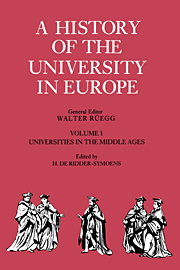Book contents
- Frontmatter
- Contents
- List of maps
- Contributors and editors
- Reader's guide
- Bibliographical abbreviations used in notes
- FOREWORD
- Acknowledgements
- PART I THEMES AND PATTERNS
- PART II STRUCTURES
- PART III STUDENTS
- CHAPTER 6 ADMISSION
- CHAPTER 7 STUDENT EDUCATION, STUDENT LIFE
- CHAPTER 8 CAREERS OF GRADUATES
- CHAPTER 9 MOBILITY
- PART IV LEARNING
- THE FACULTY OF ARTS
- EPILOGUE
- Editors' note on the indexes
- Name index
- Geographical and subject index
CHAPTER 9 - MOBILITY
- Frontmatter
- Contents
- List of maps
- Contributors and editors
- Reader's guide
- Bibliographical abbreviations used in notes
- FOREWORD
- Acknowledgements
- PART I THEMES AND PATTERNS
- PART II STRUCTURES
- PART III STUDENTS
- CHAPTER 6 ADMISSION
- CHAPTER 7 STUDENT EDUCATION, STUDENT LIFE
- CHAPTER 8 CAREERS OF GRADUATES
- CHAPTER 9 MOBILITY
- PART IV LEARNING
- THE FACULTY OF ARTS
- EPILOGUE
- Editors' note on the indexes
- Name index
- Geographical and subject index
Summary
The medieval love of travel
Medieval men loved travel. It mattered little that roads were few and that they could go only on foot or on horseback, by cart or by boat. The twentieth century thinks of the travellers thronging the roads of Europe in the Middle Ages as the ubiquitous armies, merchants going from town to town, and pilgrims. Especially pilgrims, for thousands and thousands of the faithful went on pilgrimage to the holy places of Jerusalem, Rome, or Santiago de Compostela, or to shrines nearer home. There was no lack of these in medieval Christendom, or of hostels, boarding-houses, inns, hospitals, and refuges along the pilgrimage routes.
Until the end of the eighteenth century pilgrims or travellers (peregrini) of another kind were also a familiar sight on the roads of Europe. These were the university students and professors. Their pilgrimage (peregrinatio) was not to Christ's or a saint's tomb, but to a university city where they hoped to find learning, friends, and leisure.
Literary tradition represents medieval students as undisciplined, unprincipled, bohemian, violent, footloose, all for wine, women, and song. Among the goliards there were of course real students, seekers for an alternative culture, members of a medieval intelligentsia; in their critical attitude to society they were at one with the motley crowd of clerical debauchees, ribalds, jugglers, jesters, singers, and sham students who peopled the fringes of society. Any study of wandering students must distinguish between writers and singers of carmina burana and students bent on learning and a university degree, with whom this chapter is concerned.
- Type
- Chapter
- Information
- A History of the University in Europe , pp. 280 - 304Publisher: Cambridge University PressPrint publication year: 1991
- 6
- Cited by

